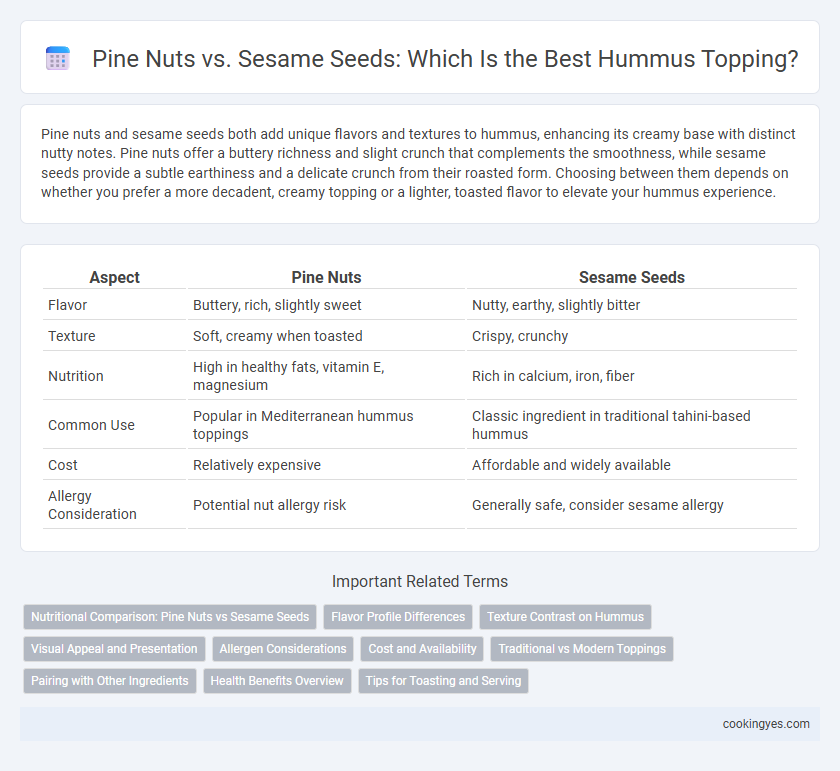Pine nuts and sesame seeds both add unique flavors and textures to hummus, enhancing its creamy base with distinct nutty notes. Pine nuts offer a buttery richness and slight crunch that complements the smoothness, while sesame seeds provide a subtle earthiness and a delicate crunch from their roasted form. Choosing between them depends on whether you prefer a more decadent, creamy topping or a lighter, toasted flavor to elevate your hummus experience.
Table of Comparison
| Aspect | Pine Nuts | Sesame Seeds |
|---|---|---|
| Flavor | Buttery, rich, slightly sweet | Nutty, earthy, slightly bitter |
| Texture | Soft, creamy when toasted | Crispy, crunchy |
| Nutrition | High in healthy fats, vitamin E, magnesium | Rich in calcium, iron, fiber |
| Common Use | Popular in Mediterranean hummus toppings | Classic ingredient in traditional tahini-based hummus |
| Cost | Relatively expensive | Affordable and widely available |
| Allergy Consideration | Potential nut allergy risk | Generally safe, consider sesame allergy |
Nutritional Comparison: Pine Nuts vs Sesame Seeds
Pine nuts offer higher protein content and are rich in monounsaturated fats, supporting heart health, while sesame seeds provide significantly more calcium and fiber, enhancing bone strength and digestion. Both toppings supply essential minerals like magnesium and zinc, but sesame seeds have a notable advantage in antioxidant properties due to their lignan content. Choosing between pine nuts and sesame seeds for hummus toppings depends on whether the focus is on protein and healthy fats or on minerals and fiber for nutritional balance.
Flavor Profile Differences
Pine nuts offer a rich, buttery flavor with a slightly sweet and resinous undertone that enhances the creamy texture of hummus, creating a luxurious mouthfeel. Sesame seeds, often toasted, provide a nutty, earthy taste with a subtle bitterness that complements the tangy lemon and garlic in hummus. Choosing pine nuts results in a smoother, more decadent topping, while sesame seeds add a robust, hearty crunch that intensifies the traditional Mediterranean profile.
Texture Contrast on Hummus
Pine nuts deliver a buttery crunch that contrasts with hummus's creamy, smooth texture, enhancing the overall mouthfeel with a delicate crispness. Sesame seeds provide a subtle, grainy texture that blends seamlessly, adding a mild crunch without overpowering the hummus's velvety consistency. The choice between pine nuts and sesame seeds influences the tactile experience, with pine nuts offering a more pronounced textural bite compared to the gentle crunch of sesame seeds.
Visual Appeal and Presentation
Pine nuts offer a glossy, golden-brown contrast that enhances the visual appeal of hummus with a rich, textured topping. Sesame seeds provide a subtle, speckled finish, creating a delicate and uniform presentation that emphasizes authenticity and simplicity. Choosing pine nuts or sesame seeds influences the hummus' aesthetic by balancing color vibrancy and surface texture for an inviting plate.
Allergen Considerations
Pine nuts and sesame seeds are common toppings for hummus but present different allergen risks. Pine nuts can trigger allergic reactions in individuals sensitive to tree nuts, posing a potential hazard for nut allergies. Sesame seeds, increasingly recognized as a top allergen, require caution due to legislation mandating clear labeling, making them a significant concern for consumers with sesame allergies.
Cost and Availability
Pine nuts, often pricier due to their labor-intensive harvesting and limited growing regions, can significantly increase the cost of topping hummus compared to sesame seeds. Sesame seeds are generally more affordable and widely available year-round, making them a cost-effective choice for both home cooks and commercial kitchens. Availability of sesame seeds in bulk and various forms, such as toasted or raw, also offers greater flexibility and consistent supply for hummus toppings.
Traditional vs Modern Toppings
Traditional hummus toppings predominantly feature sesame seeds or tahini, enhancing the dish's nutty and creamy flavors rooted in Middle Eastern cuisine. Modern variations often embrace pine nuts, offering a richer, buttery texture that adds depth and a slightly sweet contrast to the hummus base. Pine nuts provide a gourmet twist favored in contemporary culinary trends, while sesame seeds maintain authentic, time-honored appeal.
Pairing with Other Ingredients
Pine nuts add a rich, buttery flavor and crunchy texture that complements roasted garlic and sun-dried tomatoes in hummus, enhancing its depth. Sesame seeds provide a nutty, slightly earthy taste that pairs well with lemon zest and fresh herbs like parsley or cilantro, brightening the dish. Choosing between pine nuts and sesame seeds depends on whether you want a creamy, indulgent topping or a light, fresh accent to balance the flavors.
Health Benefits Overview
Pine nuts are rich in antioxidants, monounsaturated fats, and magnesium, supporting heart health and reducing inflammation when used as a topping for hummus. Sesame seeds provide a high amount of calcium, iron, and lignans, which promote bone health and have anti-cancer properties. Both options enhance hummus with essential nutrients, but sesame seeds offer greater calcium content while pine nuts provide more beneficial fats.
Tips for Toasting and Serving
Toasting pine nuts for hummus topping requires low heat and constant stirring to prevent burning and release their rich, buttery flavor. Sesame seeds benefit from a quick toast in a dry skillet over medium heat, stirring frequently until they turn golden and fragrant, enhancing their nutty aroma. Serving toasted pine nuts adds a crunchy texture and subtle sweetness, while toasted sesame seeds contribute a toasty depth, both elevating the overall flavor profile of hummus.
Pine Nuts vs Sesame Seeds for topping hummus Infographic

 cookingyes.com
cookingyes.com